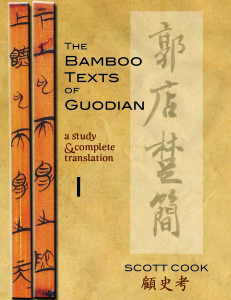Scott Cook’s extensive, two-volume study and complete translation of the Guodian excavated texts has been published and is available through University of Hawaii Press. For more information, check out these two sites (vol. 1; vol. 2), which are largely identical but have links for purchasing the two volumes at the bottom. Congratulations, Scott!
Here follows the blurb from the website:
The cache of bamboo texts recently unearthed (in 1993) from the village of Guodian, Hubei Province, is without doubt a rare and unique find in the history of Chinese philosophy and literature. As the only archaeologically excavated corpus of philosophical manuscripts to emerge from a Warring States–period tomb, the Guodian texts provide us with a wealth of reliable information for gaining new insights into the textual and intellectual history of pre-imperial China. In this respect, one may reasonably claim that they are the most exciting thing to happen to the study of early China since the third century ad, the last time a pre-imperial textual cache of similar import was unearthed. More than a few scholars have even gone so far as to suggest that their discovery necessitates that the entire history of early Chinese intellectual history will have to be rewritten. The importance of these texts is manifold. First, given the prominence of Confucian works in the corpus, they serve to fill out much of the intellectual historical picture for the doctrines of roughly three generations of Confucian disciples who fell between the times of Confucius 孔子 (551–479 BC) and Mencius孟子 (ca. 390–305 BC). Next, the discovery of three different texts that each parallel portions of the Daodejing 道德經 (aka. Laozi 老子), along with a possibly related cosmogonic work, the “Taiyi sheng shui”太一生水, is helping us better understand the formation and early transmission of the Laozi and the nature of its relationship to early Confucian thought and even popular beliefs. Moreover, the dating of the tomb serves to dispel serious doubts about the early temporal provenance of both the Laozi and many of the chapters from the Li ji 禮記 (Book of Ritual), as well as giving us a number of clues to help us reconstruct the history of the early Chinese canonical “classics” that are cited in some of the texts. And written as they are in the local Chu 楚 script, the manuscripts hold great significance for the study of early Chinese paleography and phonology, giving us tangible examples of “ancient script” forms hitherto seen mainly in early character dictionaries and a limited array of technical manuscripts previously excavated from the region.



I will defintely be adding these to my library. I was surprised by some of the ommissions though, such as the Heng Xian 恆先 and Zhou Yi 周易 (volume 3 of the Shanghai collection: 上海博物館藏戰國楚竹書), and Fanwu Liuxing 凡物流形 (volume 7). Nevertheless, a major contribution to English language studies on Chu bamboo texts. Congratulations, Scott!
Well, these are the texts found at Guodian, not the Shanghai Museum texts.
It’ll be a month or so before I can get these, but am really looking forward to reading them too.
re: “given the prominence of Confucian works in the corpus, they serve to fill out much of the intellectual historical picture for the doctrines of roughly three generations of Confucian disciples who fell between the times of Confucius 孔子 (551–479 BC) and Mencius 孟子 (ca. 390–305 BC).”
— Even if these are Confucian works – for which we’ll need a definition of what a Confucian text is – they may only represent what Chu 楚 Confucians thought and may not reflect the views of Confucians from Qi, Zhao, Qin or Han.
I got so excited by the words ‘bamboo texts,’ I overlooked the fact that Scott’s book is limited to the Guodian cache! Thanks for noticing Scott.
Having received my copy, I can’t stress what a fantastic addition this will make to anyone’s library. Printed at full-size, these two volumes have a lot of heft to them. Overflowing with notations, they are not so technical that the unitiated reader will feel bewildered. This is, without doubt, a project whose impact will be felt for generations.